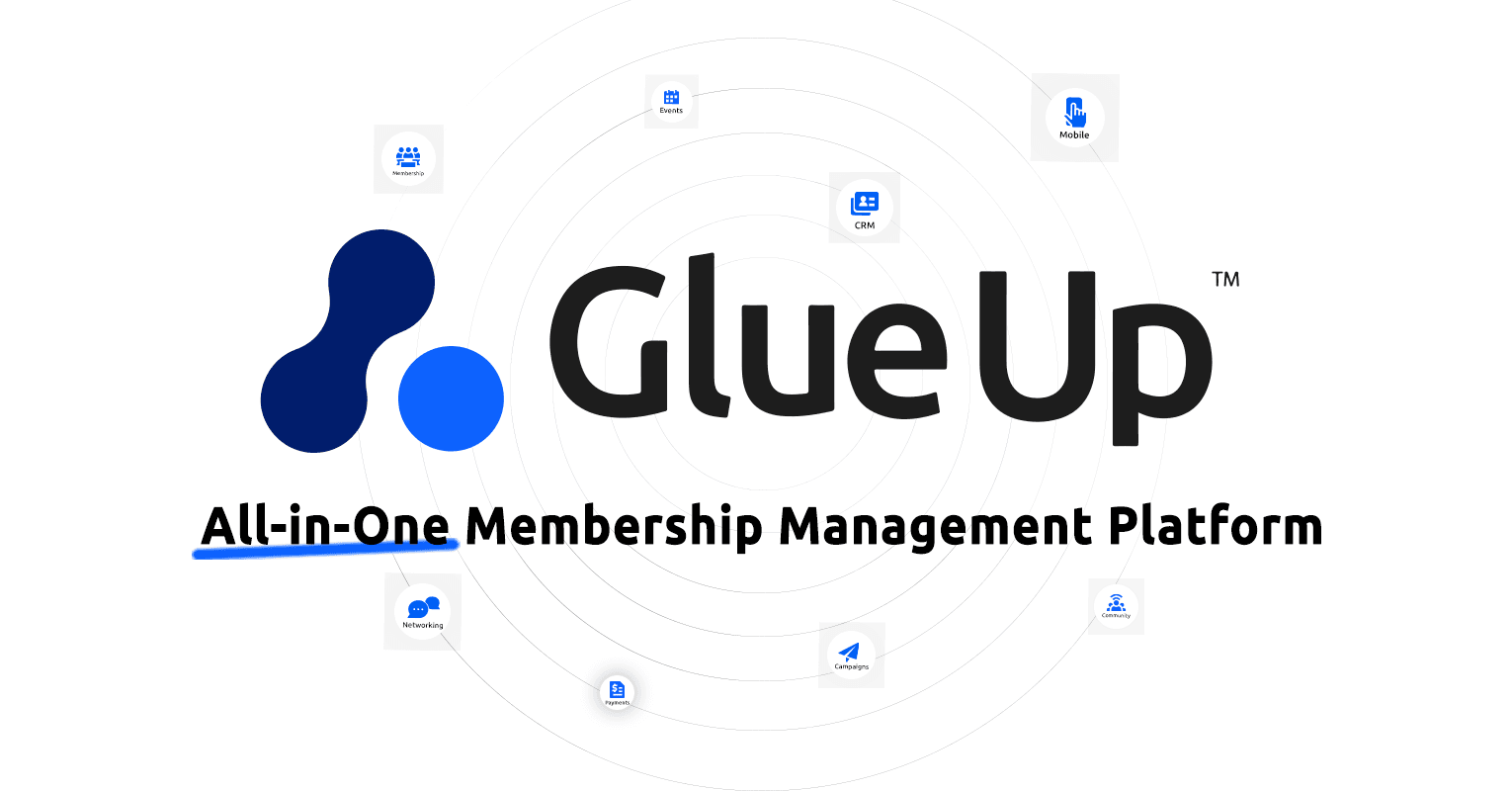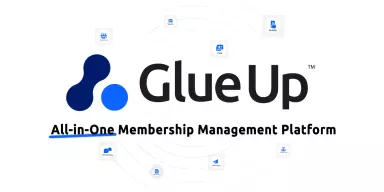
Financial transparency is showing, consistently and clearly, how every dollar is used to support your mission. Today, members want to know where their dues go, and boards expect data-driven accountability, transparency is a competitive advantage.
Associations thrive on trust. Whether that trust comes from members, sponsors, or your own board, it depends on how confidently people can interpret your numbers. Many organizations still struggle to make their financials accessible, meaningful, and credible.
Financial transparency is a skill you can build, one that Glue Up helps associations practice daily through integrated reporting, real-time dashboards, and automated processes. Below are five principles every association should adopt to turn transparency from a chore into a natural part of how you operate.
Key Takeaways
Transparency is the foundation of member trust, board confidence, and sponsor credibility. When associations clearly show how every dollar supports their mission, they strengthen engagement and loyalty.
Centralize all financial reports on a /financials page with accessible PDFs, summaries, and downloadable data. Consistent publication and visual clarity turn compliance into communication that members actually read.
Follow U.S. GAAP, FASB Topic 958, and ASC 606, but always translate complex terms into everyday language so members, staff, and the board can understand your numbers without a finance degree.
Transparency requires structure. Segregate duties, establish approval limits, perform monthly reconciliations, and maintain conflict and whistleblower policies. Regular audits or external reviews reinforce accountability.
Create weekly, monthly, and quarterly reconciliation routines. Sync CRM data, match transactions, and ensure benefits delivered align with revenue recognized to maintain compliance and trust.
Transparency is two-way. Run annual “Financials Pulse” surveys, share “What We Heard” updates, and encourage board evaluation of report clarity. Listening and responding reinforces credibility.
Pair storytelling with clarity: use visual summaries, accessible formats, and contextual notes. Post reports online with clear explanations of trends and key figures.
Monitor metrics like days cash on hand, budget variance, deferred revenue aging, and audit finding resolution rates. Publishing these KPIs quarterly demonstrates discipline and builds trust.
Within three months, associations can fully operationalize transparency by publishing a financials page, setting KPIs, automating workflows, and engaging members through surveys.
Glue Up’s Finance Suite, AI Copilot, Manager App, and Community tools automate reconciliation, simplify reporting, and turn financial visibility into an everyday process rather than an annual task.
Financial transparency is proof of integrity. With the right systems, clear communication, and Glue Up’s all-in-one platform, associations can turn financial clarity into lasting trust.'
Quick Reads
1. Publish Clearly, Post Accessibly, and Keep a Public Trail
Transparency starts with visibility. You can’t build trust if members have to search through folders, emails, or outdated PDFs to find out where funds go. Create a single, easy-to-access home for all financial documents, your /financials page.
What to include:
A two-page summary: Explain what changed compared to last year, where revenue came from, and how it was spent.
The full annual report: Post your audited financial statements and IRS Form 990s for the last three years.
Downloadable data: Offer CSV or Excel versions of key tables for accessibility and openness.
Accessible design: Ensure PDFs follow WCAG standards: tagged headings, alt text for charts, logical reading order, and proper color contrast.
When members can trace your financial history year over year, it builds confidence. When regulators, sponsors, or auditors can easily access and interpret your records, it proves diligence. And when your communication team can embed direct links to your financials in newsletters or your Glue Up-powered member portal, it turns compliance into community engagement.
Inside Glue Up’s Finance Suite, you can host links to your reports and dashboards, so members see real progress. And with AI Copilot, your team can even generate a short “Financial Summary” post each quarter that lives right inside your member news feed.
Transparency should mean visible proof of consistency.
2. Report Under Recognized Standards and Translate for Humans
The second principle of financial transparency is accuracy, and clarity. Many associations produce technically correct statements that no one outside the finance team can understand. True transparency means translating standards into plain language while maintaining compliance.
Use Recognized Standards
Follow U.S. GAAP and FASB Topic 958 for nonprofit reporting.
Apply ASU 2016-14, which requires clarity in how funds are categorized (with or without donor restrictions).
If you collect dues tied to services or benefits, apply ASC 606 to ensure correct revenue recognition.
Translate for Real People
Your members don’t think in debits and credits. Add short, simple summaries:
Liquidity disclosure: “We have enough unrestricted reserves to operate for 120 days.”
Net assets: “Restricted funds are like promises, money we can use only for specific programs.”
Functional expenses: “Eighty-two percent of our spending goes to programs that directly benefit members.”
Plain English is powerful. It removes barriers and invites participation. When members understand what “restricted” or “deferred” means, financials become shared understanding.
Glue Up’s AI Copilot can help translate accounting jargon into member-friendly explanations. Imagine summarizing your 30-page audit into a 300-word plain-language report that your board actually reads. That’s real transparency in action.
3. Build Internal Controls and Independent Oversight
Even the best report is meaningless if your systems behind it aren’t secure. The third principle of financial transparency is control, how you ensure accuracy, prevent misuse, and build accountability from the inside out.
Build Strong Internal Controls
Internal controls are your guardrails.
Segregate duties: No one should control both payments and reconciliation.
Approval thresholds: Require dual sign-offs for expenses above a set limit (e.g., $5,000).
Bank reconciliations: Reconcile every account monthly, ideally by someone independent of disbursements.
Conflict of interest policy: Have annual disclosures for all board and staff members.
Whistleblower channel: Make it safe and anonymous for anyone to report financial concerns.
Establish Independent Oversight
Your audit committee should meet quarterly and have a formal charter. The committee should review audit findings, track progress on management letter items, and meet privately with the auditor. If you’re a smaller association, consider a financial review by an external CPA every year.
Glue Up simplifies this structure. Through roles and permissions, you can define who has authority to view, approve, or edit transactions. The system logs every action for audit tracking, while the Manager App allows leaders to approve or reject financial requests from anywhere.
Transparency works best when accountability is baked in.
4. Reconcile Dues and Program Revenue Precisely and On Time
For many associations, dues and events make up the majority of revenue. But delayed reconciliation or inconsistent tracking often leads to mistrust. Principle four of financial transparency focuses on timeliness and precision.
The Weekly Routine
Sync your membership data with accounting. Every paid invoice should map to a specific member record.
Reconcile payment processor reports (Stripe, PayPal, etc.) weekly.
Log exceptions for discrepancies and track resolutions.
The Monthly Routine
Update your deferred revenue schedules, recognize dues as members receive benefits.
Match event income with registration lists and expenses.
Review and post refunds, credits, and discounts accurately.
The Quarterly Routine
Conduct a sample test by selecting several member accounts and verifying that the benefits those members received align with the revenue recognized for them during the same period. At the same time, review any conditional contributions to confirm that all requirements have been met before recognizing the income, ensuring full compliance with accounting standards.
Reconciliation builds credibility. When numbers are current, boards make decisions with confidence, and members trust what they read. A delay in reconciliation is a finance problem and a communication gap.
Glue Up makes reconciliation effortless. Membership records, event payments, and invoices flow into the Finance Suite, where you can view dues, outstanding balances, and payments in real time. Smart Lists flag anomalies automatically, saving hours of manual checking.
When your systems talk to each other, accuracy stops being an afterthought, it becomes automatic.
5. Invite Feedback and Close the Loop
Transparency is two-way. You can publish all the statements you want, but the real test is whether people understand and feel included in the process. The final principle of financial transparency is engagement, inviting feedback, listening to it, and showing how it shapes your next move.
Ask for Input
Send an annual “Financials Pulse” survey to members. Ask:
How clear are our reports?
What information would help you understand our financial health better?
Do you trust the way we use funds?
Share What You Heard
In your next newsletter or general meeting, publish a section titled “What We Heard, What We’re Doing.” Show that you acted on feedback, even if the action was clarification rather than change. This demonstrates humility and responsiveness.
Keep the Board Involved
Your board should review the quality of financial communication. Encourage them to score your reports for clarity and accessibility. Discuss these scores openly.
Trust is emotional before it’s numerical. Members stay engaged when they feel seen and informed. Sponsors stay when they feel confident in your financial discipline. And your team works better when they know decisions are backed by clarity.
Glue Up’s Community Module makes this feedback process easy. Post a quick survey, collect responses, and analyze trends. Then, let AI Copilot summarize the insights and draft your next update. It’s transparency as a continuous dialogue.
How to Publish and Format Your Annual Financial Report
Even with the best data, poor presentation can undo the perception of transparency. Your annual report should combine clarity, accessibility, and storytelling.
The Two-Page Summary
Open with mission highlights, then present:
Total revenue and expense summary
Top three program outcomes
Graphs showing where money came from and where it went
A short “What changed this year” section
The Core Financial Statements
Include:
Statement of Activities
Statement of Financial Position
Statement of Cash Flows
Statement of Functional Expenses
Notes (liquidity, restrictions, commitments)
Design for Readability
Keep it visual and human. Avoid dense paragraphs. Use icons or small infographics for key stats (“82% program spending,” “$1.2M in reserves”). Ensure all visuals are accessible with color-safe palettes and alt text.
Post Accessibly
Your /financials page should have:
HTML version (mobile responsive)
Accessible PDF version
CSV downloads
990 links
Record retention policy statement
Glue Up’s Finance Suite lets you link your live dashboards to your report, so you’re showing it, in real time.
Internal Controls in a One-Page View
If your board had only one page to understand your financial discipline, what would it show? Here’s how to structure it:
| Process | Who Executes | Who Approves | Verification | Recordkeeping |
|---|---|---|---|---|
| Vendor Payments | Finance Staff | Executive Director | Dual approval | Audit trail |
| Expense Reimbursements | Staff | Department Head | Receipt check | Ledger record |
| Bank Reconciliations | Accountant | Treasurer | Monthly review | Signature log |
| Credit Card Use | Authorized Staff | Manager | Receipt upload | Program tagging |
| Conflict Disclosures | All Staff & Board | Secretary | Annual collection | Stored digitally |
| Whistleblower Reports | Any Party | Audit Chair | Investigation | Final resolution note |
Glue Up automates much of this workflow. Every action in your Finance Suite creates a traceable record. Roles ensure no overlap of critical duties. The Manager App allows mobile approvals, so oversight doesn’t pause when leadership travels.
That’s control you can demonstrate.
KPIs That Define Real Transparency
You can’t manage what you can’t measure. Here are nine key performance indicators that demonstrate financial transparency to members and boards alike:
Days Cash on Hand – liquidity measure for operational resilience.
Operating Margin (Unrestricted) – sustainability of core operations.
Deferred Revenue Aging – how promptly revenue is recognized.
Program vs. Admin Ratio – contextual spending pattern.
Budget Variance by Program – deviations explained with context.
Close-Cycle Time – days from month-end to finalized reports.
Audit Findings Closed Within 90 Days – responsiveness to oversight.
Disclosure Timeliness – days between year-end and publication.
Public Transparency Seal (Candid or equivalent) – external verification.
When published quarterly, these KPIs tell a powerful story: “We know our numbers, and we’re confident sharing them.” Glue Up dashboards let you visualize these metrics instantly, turning static finance into dynamic intelligence.
Turning Principles into Practice
These five principles are habits that build culture. When your members know how their dues are spent, they renew. When your sponsors see discipline, they invest. When your board sees data clarity, they lead better.
Here’s a 90-day action plan to operationalize financial transparency inside your organization:
Days 1–15
Create a “Financials” page.
Post your policy and your last three reports.
Define KPIs and baseline metrics.
Days 16–45
Implement reconciliation checklists in Glue Up.
Set up approval roles and audit trail logging.
Train your board on reading financials.
Days 46–90
Launch your first “Financials Pulse” survey.
Publish your member-facing summary using AI Copilot.
Review responses and release a “What We Heard” update.
By the end of three months, your association will practice it.
How Glue Up Makes Financial Transparency Simple
Glue Up connects all the moving parts of transparency in one place; your CRM, events, finance, and member communication tools; so financial visibility becomes an everyday function.
Here’s how:
Membership CRM + Finance Integration: Every payment or renewal flows into finance automatically.
Event Management + Finance Suite: Revenue tracking and refunds sync instantly.
AI Copilot: Converts raw data into plain-English summaries for members and boards.
Manager App: Enables mobile approvals and oversight for leadership.
Community + Email Modules: Let you survey members, share reports, and close the loop with real engagement.
With Glue Up, financial transparency becomes your daily operating standard.
Trust Is Built in the Details
Trust comes from how those numbers are shared, explained, and acted upon. When your association can open its books confidently, demonstrate accuracy, and invite dialogue, you achieve and you create belonging.
Your finances tell your story. Make sure it’s one your members want to read.
Book a demo today and discover how Glue Up can make your financial transparency effortless, accurate, and engaging for every stakeholder.



